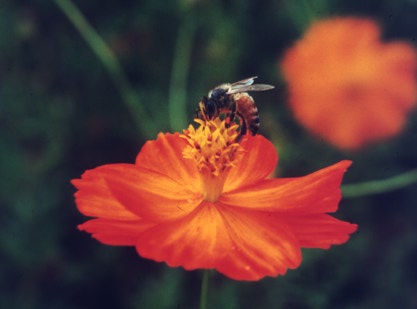
Grades: 4-6
Essential Skills: Health, Science, Language Arts, Math
Duration: 1 class period

OVERVIEW
Students learn about honey bee anatomy. At the completion of the lesson, students will be able to characterize six primary anatomical characteristics of a honey bee and discuss their functions.
Preparation
Curriculum Support Materials:
Information Sheets:
Activity Sheets:
Lesson Plan
Introduction activity (20 minutes)
See grade cluster K-3, Lesson 1.1 for beginning Honey Bee Body activities. This lesson will build upon those activities. Discuss the basic bee body parts with the students to ascertain their base knowledge of honey bee anatomy. Show Poster 1 (Honey bee collecting pollen) to stimulate the discussion. Review body parts, such as head, thorax, abdomen, wings, legs, simple eyes, compound eyes.
Activity 1 Making a honey bee model (30 minutes)
Have the students examine a slide of a honey bee's leg under the microscope and look at drawings of honey bees. Give each student a copy of Activity Sheet 26 (parts of a honey bee head) and Activity Sheet 27 (worker honey bee hind leg). Review and discuss the structures depicted.
Encourage students to construct bee models out of a variety of materials such as ballons, paper mache, clay and/or egg cartons, or draw a picture of a worker bee based on what they see. Encourage them to include as many special structures as possible. This will help them equate form and function.
Activity 2 Collecting pollen (10 minutes)
Demonstrate how pollen gets on the bee's body by sprinkling cold cooked rice into a hairbrush. Them comb the rice out using the comb. Press two combs together to represent the pollen press. Then mash the rice into a ball in the bowl.
Conclusion (20 minutes)
Pollination is the movement of pollen from the male part of the flower to the female part. Have students discuss why pollination by insects is important. Give each student a copy of Activity Sheet 10 (Plants pollinated by insects). How would their diets be different if those foods were not available? Have the students relate aspects of the honey bee's anatomy (such as their hairiness) to their ability to pollinate flowers.
Additions
Words with special meanings:
(for understanding only, not to be tested)
Bibliography:
A Scanning Electron Microscope Atlas of the Honey Bee,
by E.H. Erickson, Jr., S.D. Carlson and M.B. Garment. Published by Iowa State University Press, Ames, IA, 1986.
The Fascinating World of Bees, by A. Julivert. Published by Barrons, N.Y., 1991.
All Kinds of Bees, by D. E. Shuttlesworth. Published by Random House, N.Y., 1967.
Anatomy of the Honey Bee, by R. E. Snodgrass. Published by Comstock Publishing Associates, Ithaca,
N.Y., 1956. Text is technical. Available from Wicwas Press, Chesire CT.